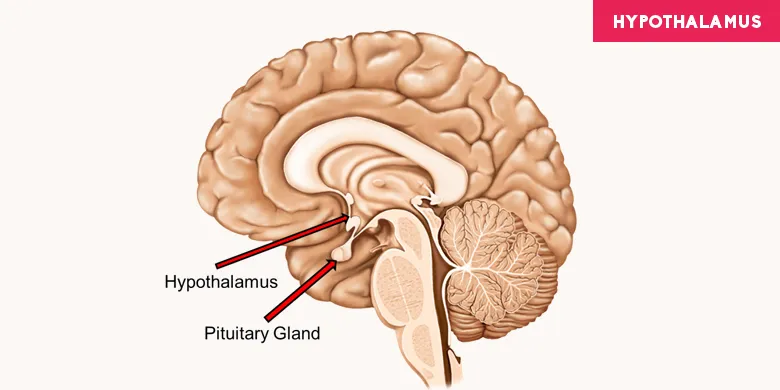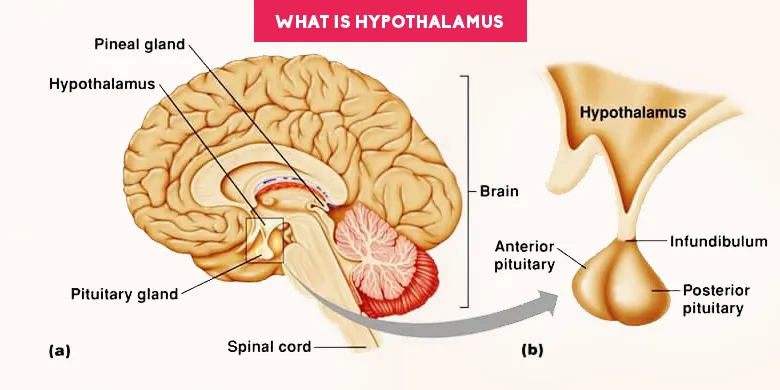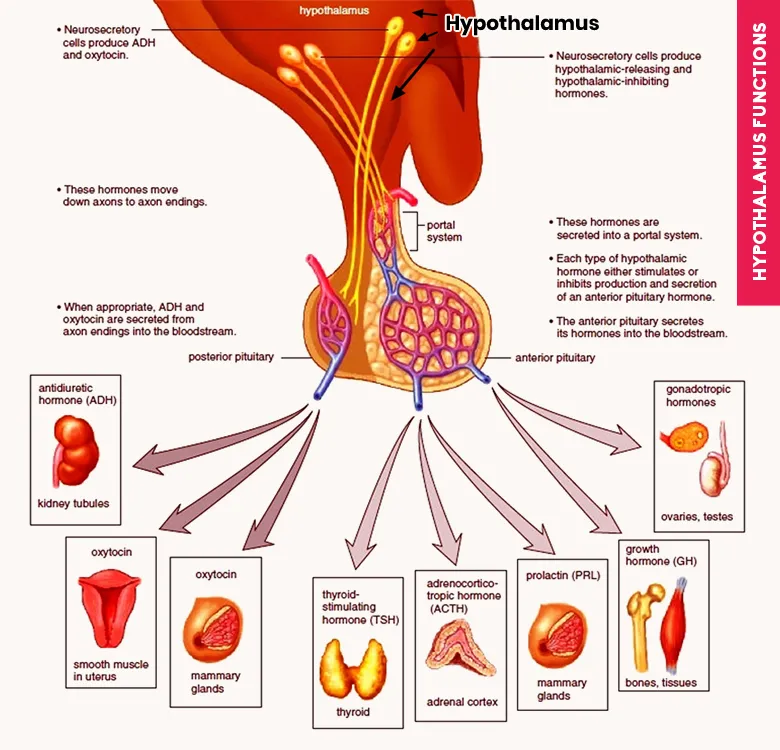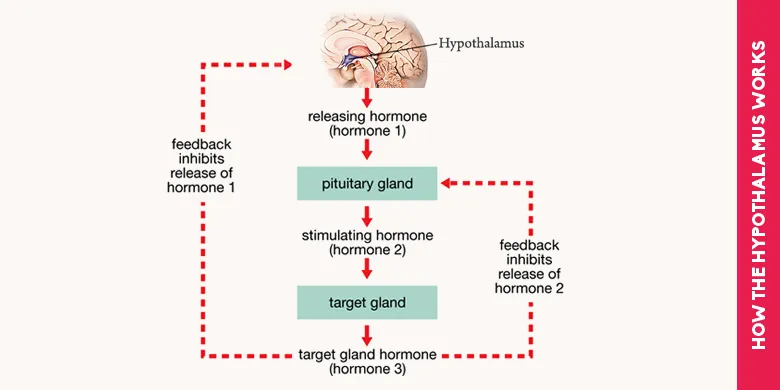What is Hypothalamus? and How it works?
Here you will get comprehensive answers to all these questions. In addition, you will also learn about the anatomy, functions and working of the hypothalamus.
What is Hypothalamus?
The hypothalamus was first identified and described as a distinct region in the diencephalon by ‘His’ as early as 1893. This revolutionary discovery paved the way for further research on this important unit of the brain.

It is a structural and functional unit or region in the brainwhose name is familiar to all neurobiologists.
However, they may not claim to understand perfectly the position, limits and inner surface in context of the surrounding territories of the forebrain.
In fact, there is controversy regarding the morphological model of the hypothalamus and that best accounts for its complexity.
Despite an ample number of neurogenetic and genoarchitectonic studies, it is still largely a matter of conjecture how hypothalamus is regionalized during the developmental processes.
The hypothalamus is responsible for the control and regulation of a number of body function, like drinking, eating, reproduction, heat production, homeostatic mechanisms of the body, and so on.

Hypothalamus Functions:
Ranson and Hess and their colleagues observed that localized electrical stimulation of certain sites within the hypothalamus created profound effects on a range of behaviours, including feeding, drinking, responses to stress, thermoregulatory responses, autonomic functions and reproductive behaviour.
At that time, it was believed that such effects were the result of actions on the neural cell bodies within the hypothalamus.
But, now it has been realized that the effects of lesions or electrical stimulation may also be due in part to effects on the descending or ascending axons of passage within the hypothalamic region.

It is an established fact that the hypothalamus is an important central station that is involved in the networked control of organismic humoral homeostasis, central control, motor drives, self-placing computation and patterns of circadian neural activity.
After receiving signals based on internal and external conditions, the hypothalamus translates them into hormones which inhibit or stimulate the secretions by the pituitary gland.
Through its secretions, the hypothalamus regulates the body functions, like growth, metabolism, development of sex cells (ova and sperm), stimulation of ovaries and testes, and so on.
The hormones secreted by the hypothalamus include corticotropin-releasing factor (CRF), gonadotropin-releasing hormone (GnRH), growth hormone-releasing factor, somatostatin and thyrotropin-releasing factor.
In response to the action of these hormones, the pituitary gland gets stimulated to synthesize different types of hormones.
For example, CRF stimulate the master gland (the pituitary) to produce adrenocorticotropic hormone or ACTH.
It produces the follicle-stimulating hormone (FSH) and luteinizing hormone (LH) in response to the effect of GnRH. Similarly, the pituitary produces growth hormone (GH) and thyroid-stimulating hormone (TSH), in response to the secretions of growth hormone-releasing factor and thyrotropin-releasing factor, respectively, by the hypothalamus.
Here, as the very name suggests, the job of the thyroid-stimulating hormone is to stimulate secretions by the thyroid gland.
Present in the neck region, the thyroid gland is a large ductless gland that produces hormonal secretions which regulate the processes, like growth and development, by controlling the rate of metabolism.
Hypothalamus Anatomy:
Anatomically, the region of the brain called hypothalamus can be subdivided both mediolaterally and rostrocaudally.
In the mediolateral direction, the hypothalamus can be traditionally divided into three distinct longitudinal cell columns which are referred to as periventricular, medial and lateral zones.

The medial zone contains most of the major nuclei of hypothalamus which usually have a distinct cytoarchitecture.
On the other hand, the neurons of the lateral zone are more diffusely distributed and do not have anatomically distinct nuclei.
Rostrocaudally, the hypothalamus is most commonly divided into three structural components, called the anterior, middle and posterior parts.
The anterior, middle and posterior parts of the hypothalamus are also referred to as the preoptic area, the tuberal part and the mammillary part, respectively.
There are short capillaries which connect the hypothalamic region of the brain to the pituitary gland.
How the Hypothalamus Works?
The job of the hypothalamus is to translate the signals received from the nervous system into hormonal secretions.
These hormones activate the pituitary gland to synthesize or inhibit specific hormones in response to the signal from hypothalamus.
Both external conditions, like light or temperature,and internal conditions, like fears, play an important role in the translation of the signals by the hypothalamus into the hormones which stimulate or inhibit the pituitary gland.
The conditions, like temperature, heat and fears are processed by other areas of the brain and then communicated to the hypothalamus through the neural signalling.

So, it can be said that the hypothalamus serves as a critical link between the endocrine system and the nervous system.
The pituitary (also referred to as the master gland because itregulates the hormonal secretions of several other glands) is positioned at the base of the human brain just beneath the hypothalamus.
Both the parts of the pituitary (anterior and posterior) receive inputs from hypothalamus in very different ways.
The hypothalamus uses the route of direct blood supply (consisting of unique vasculature) to send hormonal signals to the anterior part of the pituitary gland.
On the other hand, the posterior part of the pituitary is more like an extension of hypothalamus in that it is made primarily of the axons of the hypothalamic neurons.
References:
- Alvarez-Bolado, G., Grinevich, V., &Puelles, L. (2015). Development of the hypothalamus. Frontiers in neuroanatomy, 9, 83.
- Benson, J. B., & Haith, M. M. (Eds.). (2009). Diseases and Disorders in infancy and Early Childhood. Academic Press.
- Llewellyn-Smith, I. J., &Verberne, A. J. (Eds.). (2011). Central regulation of autonomic functions. Oxford University Press.
In This Article You Will Know:
- Which part of the brain controls homeostasis and homeostatic behaviours like drinking and eating?
- How does your body control the processes like the production of heat, growth and reproduction?
- Does the hypothalamus play any role in hypertension and hormonal dysfunctions?
- Who was the first to identify the hypothalamus as a distinct region within the brain?


